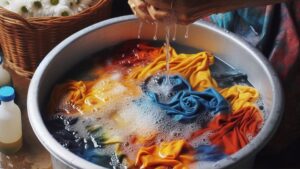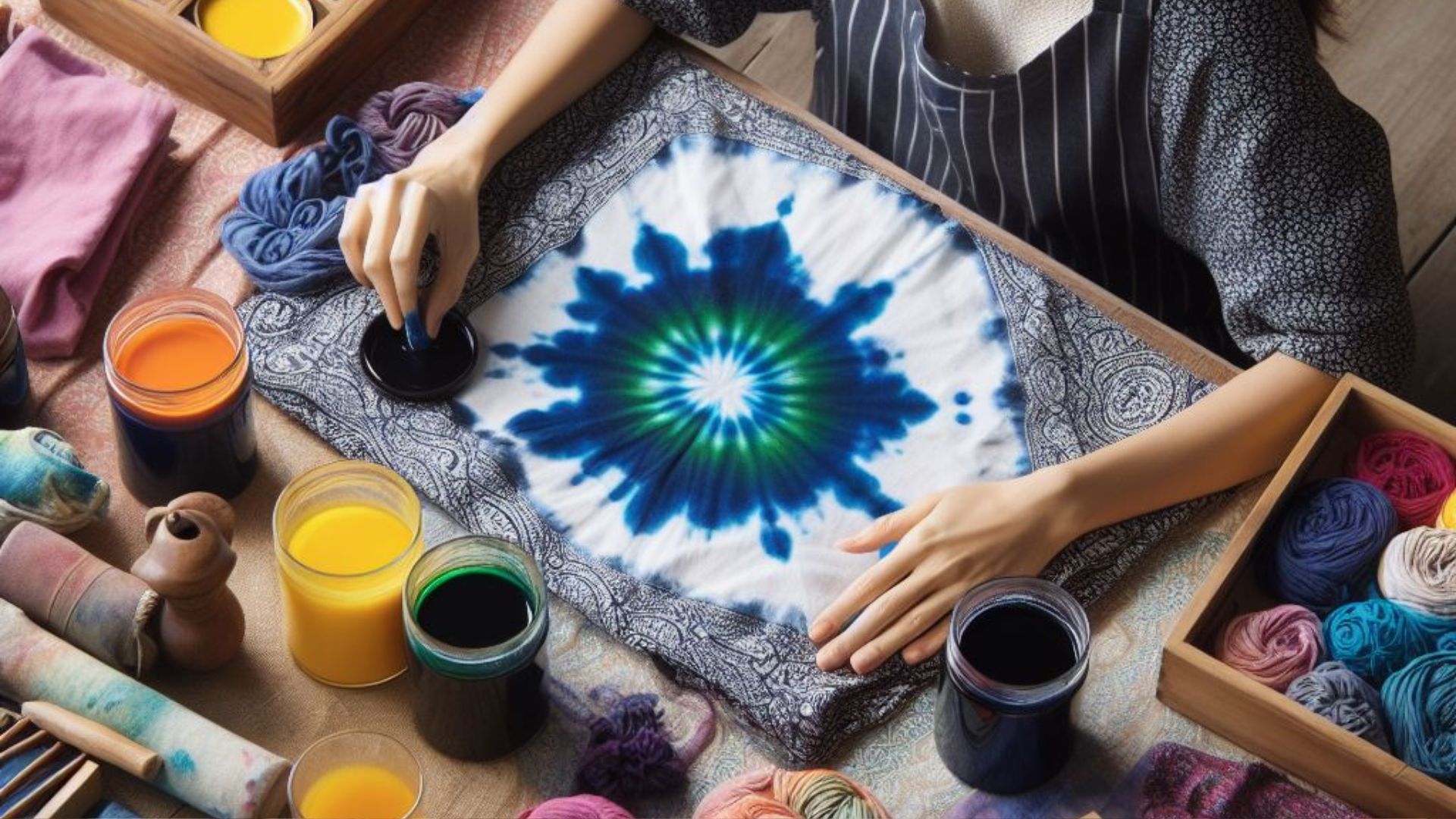Tie-dyeing is a vibrant and creative way to add a burst of color to fabrics. While the dyeing process itself is essential, the setting phase is equally crucial to ensure those beautiful patterns last. Sunlight, known for its natural powers, often plays a role in setting tie-dye. Let’s dive into the impact of sunlight in this colorful process.
How Does Sunlight Help Set Tie-Dye?
Sunlight, specifically UV rays, aids in the setting of tie-dye by facilitating the chemical reaction between the dye and the fabric. When tie-dyeing, the fabric is soaked in dye and typically left bound in specific patterns. The UV rays from sunlight help to activate the dye molecules, allowing them to penetrate and bond with the fabric fibers more effectively.
Factors to Consider When Using Sunlight to Set Tie-Dye
- Time of Day: Opt for setting tie-dye in the morning or late afternoon when the sun’s rays are less intense. This can prevent excessive fading or damage to the fabric.
- Duration: The duration needed for setting tie-dye can vary based on the dye type, fabric, and intensity of sunlight. It’s advisable to check the dye’s instructions and monitor the fabric periodically to avoid overexposure.
- Fabric Type: Different fabrics react differently to sunlight. Natural fibers like cotton and linen tend to absorb dyes better, while synthetic fabrics might require more time or alternative setting methods.

Precautions When Using Sunlight for Setting Tie-Dye
While sunlight can be beneficial, it’s essential to take precautions to ensure the best results:
- UV Protection: Protect your skin by wearing sunscreen if you’re spending extended periods in the sun.
- Fabric Protection: To avoid excessive fading or damage, consider flipping the fabric periodically during the setting process to ensure even exposure.
- Environmental Factors: Be mindful of weather conditions. Wind, humidity, or sudden rain can affect the setting process and the final outcome.
Alternative Methods for Setting Tie-Dye
If sunlight isn’t readily available or practical, other methods can effectively set tie-dye:
- Heat Setting: Using a hot iron or placing the fabric in a dryer on a high-heat setting can help set the dye.
- Chemical Fixatives: Some dyes come with fixatives that don’t rely on sunlight, offering an alternative for setting tie-dye indoors.
So,…
Sunlight can indeed be a valuable tool in setting tie-dye, enhancing the vibrancy and longevity of the colors. However, it’s crucial to consider various factors like fabric type, duration, and environmental conditions for optimal results. Whether basking in the sun or exploring alternative methods, setting tie-dye ensures your creations remain as vivid and eye-catching as intended!
For further exploration on tie-dye techniques and patterns, check out these resources:
- Tie-Dye Patterns and Ideas: Get inspired by diverse tie-dye patterns and techniques.
- Understanding Fabric Types for Tie-Dye: Learn about different fabrics and how they interact with tie-dye processes.
- DIY Tie-Dye Tips and Tricks: Explore a comprehensive guide with tips for successful tie-dye projects.
Maximizing Tie-Dye Brilliance: Sunlight’s Role Explored Further
Now that we understand sunlight’s impact on setting tie-dye, let’s delve deeper into some key aspects and additional tips for a successful tie-dye adventure.
Understanding Sunlight’s Influence on Color Intensity
The strength and vibrancy of tie-dye colors can be significantly affected by sunlight. While it aids in setting the dye, prolonged exposure to intense sunlight might lead to:
- Fading: Overexposure to harsh sunlight can cause colors to fade more quickly, compromising the brilliance of your tie-dye creation.
- Bleeding: If the dye hasn’t fully set and the fabric is exposed to water or moisture during extended sunlight exposure, colors might bleed or blur, altering the intended patterns.
Optimal Conditions for Sunlight-Based Tie-Dye Setting
Achieving the best results when using sunlight to set tie-dye involves careful planning:
- Choosing a Location: Find a well-ventilated outdoor spot with ample sunlight. Consider using a clothesline, hangers, or a flat surface to lay out the dyed fabric for even exposure.
- Timing: Aim for a balance between sufficient sunlight exposure and avoiding the peak intensity hours (usually around midday) to prevent potential damage to both fabric and colors.
- Monitoring the Process: Regularly check the fabric to ensure the colors are setting without overexposure. Adjust the position or cover the fabric if necessary to maintain the desired colors.
Enhancing Tie-Dye Longevity Beyond Sunlight
To preserve tie-dye vibrancy and ensure lasting results, consider these additional tips:
- Washing Care: Wash tie-dyed fabrics separately and use cold water to help preserve the colors. Using a mild detergent can prevent colors from fading prematurely.
- Avoiding Direct Heat: When drying tie-dye items, avoid high heat settings in dryers or direct sunlight exposure. Air drying in shade is preferable to maintain color integrity.
- Storing Properly: Store tie-dyed items away from direct sunlight to prevent unnecessary fading when not in use. Fold or hang them carefully to avoid color transfer or creasing.
Conclusion: Sunlight as a Creative Ally in Tie-Dyeing
Sunlight contributes significantly to the process of setting tie-dye, enhancing the brilliance and durability of colors. However, it requires a delicate balance between exposure and care to achieve optimal results. Understanding how sunlight influences the dye setting process empowers tie-dye enthusiasts to create vibrant, long-lasting designs while exploring alternative setting methods when necessary.
Ready to embark on your tie-dye journey or expand your dyeing repertoire? These resources offer further insights and inspiration:
- Advanced Tie-Dye Techniques: Explore advanced tie-dye techniques to elevate your designs.
- Tie-Dye Troubleshooting Guide: Troubleshoot common tie-dye issues and learn how to avoid them.
- Natural Dyes for Tie-Dye: Discover eco-friendly options using natural dyes for tie-dye projects.
Comparison tabular
Here’s a comparison table highlighting the impact of sunlight versus alternative methods for setting tie-dye:
| Aspect | Sunlight | Heat Setting | Chemical Fixatives |
|---|---|---|---|
| Setting Mechanism | UV rays aid in activating dye molecules and bonding with fabric fibers. | High heat from iron or dryer helps set the dye by heat activation. | Chemicals within fixatives create a bond between dye and fabric. |
| Impact on Colors | Enhances vibrancy but prolonged exposure can lead to fading or bleeding. | May maintain color intensity but excessive heat can cause fading. | Generally preserves colors without sun dependency but may contain chemicals. |
| Convenience | Requires outdoor space, weather consideration, and monitoring. | Convenient for indoor use but requires electricity and cautious heat application. | Indoor-friendly but relies on specific products and additional chemical usage. |
| Setting Time | Variable based on sunlight intensity, fabric type, and dye used. | Relatively quick, depending on heat level and fabric type. | Follows product instructions, often requiring shorter time frames. |
| Environmental Impact | Uses natural sunlight but can be affected by weather conditions. | Requires energy consumption for heating, less reliant on weather. | Contains additional chemicals, potentially less eco-friendly. |
Understanding these methods’ nuances can help in choosing the most suitable approach based on preferences, resources, and desired outcomes for setting tie-dye.
Wrapping up
In the colorful world of tie-dye, the setting phase holds the key to preserving those vibrant hues and intricate patterns. Whether basking in the sun’s natural glow, harnessing the heat of an iron, or opting for fixatives, each method contributes uniquely to securing those kaleidoscopic designs.
Sunlight, with its natural essence, enhances tie-dye brilliance, but it’s not the sole path to vibrant creations. Consider the setting method that aligns best with your preferences, environment, and the desired longevity of your tie-dye masterpiece.
So, embrace the hues, experiment with patterns, and dive into the tie-dye journey, knowing that whether under the sun or within the comfort of your home, your colorful creations will continue to captivate and inspire. Happy tie-dyeing! 🌈✨

For over a decade, I’ve been Mike, an artist, crafter, and designer deeply immersed in the Croc world. I thrive on crafting unique, size-inclusive patterns, fostering creativity, and sharing them on ktforum.com. My designs aim to ignite your creative spark and delight you, ensuring clarity and ease of use through rigorous testing. Join me in expressing your creative flair and showcasing your craft with joy.
Related Posts
- Accelerating the Tie-Dye Setting Process: Hairdryer or Fan?
Tie-dyeing is an art form that’s not just about colors; it’s about patience and precision.…
- Is There a Risk in Delaying Tie-Dye Setting After Application
Tie-dyeing is a vibrant and creative way to breathe life into fabrics, but timing is…
- To Set or Not to Set: Understanding the Tie-Dye Setting Process
Tie-dyeing is a fantastic way to infuse vibrant colors and creative designs into fabrics. Yet,…
- Understanding Tie-Dye Settling and Mixing with Other Dye Projects
Tie-dyeing is a vibrant and creative way to infuse life into fabrics, but ensuring colors…

